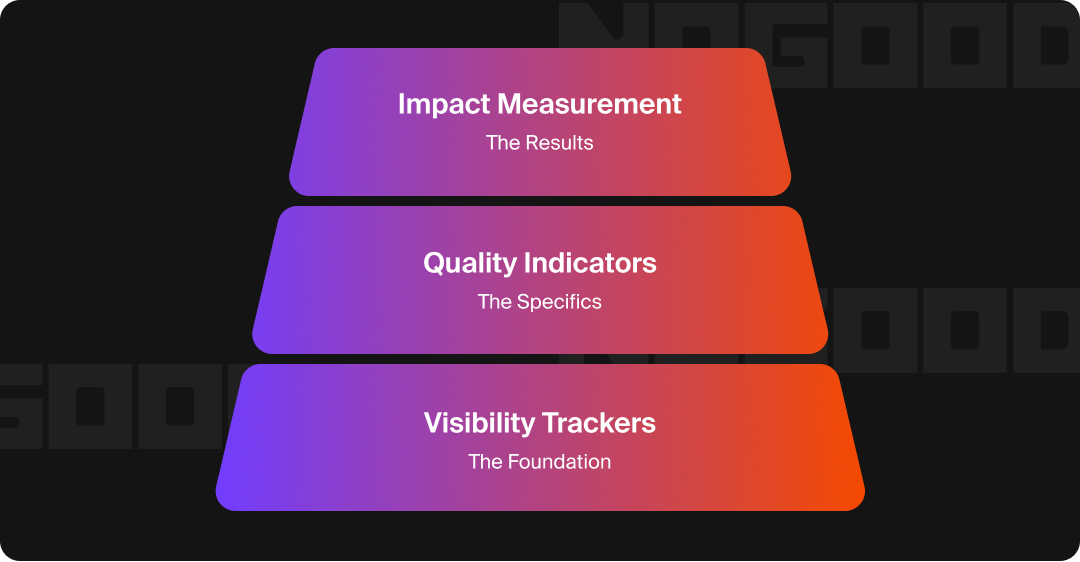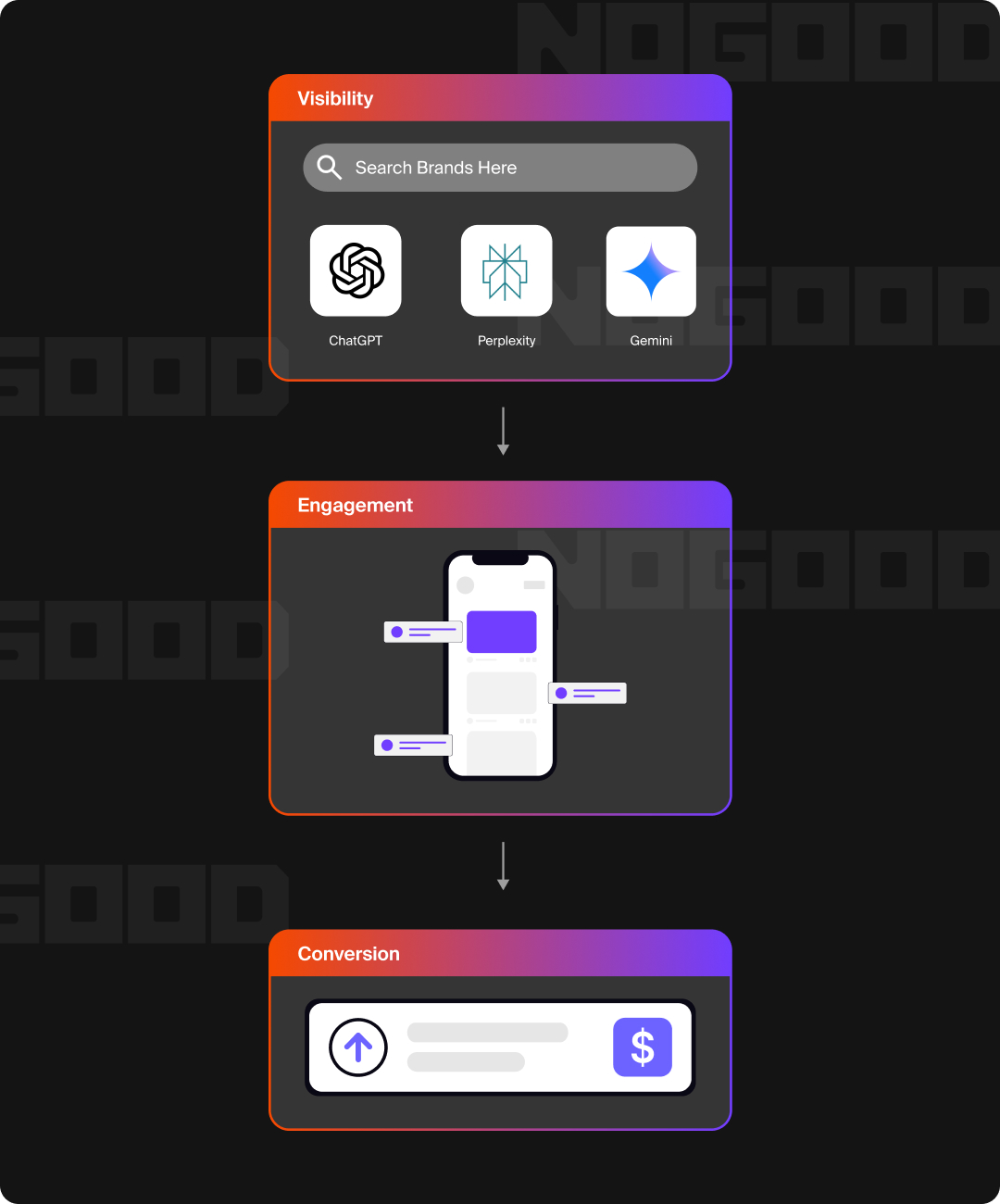The uncomfortable truth for SEO managers is that to succeed and overcome the trend of organic traffic dropping, they need to truly embrace strategies for the zero-click era.
But they shouldn’t just be diving into Answer Engine Optimization without understanding what their targets are, or using SEO tactics to create content and cross their fingers hoping it’s enough for their brand to show up when someone asks ChatGPT or Gemini about their industry.
Remember: hope and luck aren’t a strategy. And unlike SEO, where you can check your rankings in Google Search Console and specialized tools like Ahrefs, AEO measurement feels like trying to track an intangible metric.
The same question asked twice might give you completely different answers. ChatGPT doesn’t provide a dashboard to track your brand’s visibility. However, there are third party sites like Goodie AI that can track brand visibility and make real recommendations.
So how do you actually know if your AEO efforts are working? This article breaks down a practical framework going beyond vanity metrics and actually helping you make smart decisions.
Why Traditional SEO Metrics Don’t Work for AEO
It may seem like a good idea to transplant your SEO measurements to AEO, but we’re here to set that straight. No, your SEO metrics aren’t enough to show your success, nor your failures.
With AEO, the goal isn’t necessarily to drive instant traffic or direct conversions. Instead, it’s about brand discovery and presence within AI-generated responses.
Why should you as a brand care? Because users often don’t go beyond the initial AI-generated answer. There’s no need to click a link, scroll through pages, or open multiple tabs. The AI delivers the entire response in one go. And yet, this interaction can significantly influence user behavior.
Even without a click, an AI-generated brand mention:
- Builds brand awareness
- Establishes credibility through AI’s “endorsed” answer
- Influences future searches, conversations, and buying decisions
For example, If your brand is listed in ChatGPT as a top tool in your industry, that mention may not lead to immediate traffic. Instead, it acts as a brand awareness play, increasing the chances of users later searching for your brand, visiting your site, or converting through another channel.
Since this is more difficult to measure, SEOs have been asking whether they can just use traditional SEO metrics like rankings, impressions, and click-through rates for a clear map of performance. The answer is two-fold.
- Traditional SEO is deterministic. If you rank #3 for “project management software” today, you’ll probably rank #3 tomorrow (barring any major Google algorithm updates).
- AEO is probabilistic. Ask Claude the same question five times, and you might get five slightly different answers. This is because the AI isn’t pulling from a fixed index; it’s generating responses based on patterns in its training data, plus whatever it retrieves from the web in real-time.
I know you were probably reading this article hoping we’d give you the magic formula to show your AEO successes; unfortunately, measuring ROI for AEO isn’t about a simple formula. Instead, it’s about understanding the whole picture.
This means solely tracking “rankings” in the traditional sense is pointless. Instead, you need to think in terms of presence probability and influence measurement.
The Three-Layered Strategy for Measuring & Tracking AEO Performance

Layer 1: Visibility Tracking
Before creating any strategy, you need to give your brand a baseline. The baseline consists of two main pieces.
- Real visibility score
- Visibility score compared to your competitors
AI Visibility trackers measure a combination of four factors through in-depth tracking. Sure, you can do it the scrappy way: creating a bank of 20-30 prompts based on your priority topics and inputting those individual prompts directly into each LLM.
As you can imagine, that is extremely time-consuming, and doesn’t give you the full picture of your brand visibility compared to AI visibility platforms like Goodie that index thousands (sometimes hundreds of thousands) of prompts in near real-time. Platforms break down their prompts into these four factors:
- Mention Frequency: How often does your brand appear in AI responses for industry-relevant queries?
- Position Prominence: When you do appear, are you mentioned first, buried in the middle, or listed as an afterthought?
- Context Accuracy: Is the AI describing your product or service correctly?
- Competitor Displacement: Are you appearing instead of competitors who used to dominate these queries?
Layer 2: Quality Indicators
Showing up is good. Showing up well is better. This layer measures how the AI talks about you. Think of it as the way LLMs understand your brand. They look for authority and expertise from sites beyond your own website.
Breakdown of Essential Metrics to Track
- Sentiment Analysis: Is the mention positive, neutral, or negative?
- Detail Richness: Does the AI provide specific, accurate details about your offering?
- Use Case Alignment: Is your brand mentioned for the right reasons and contexts?
- Authority Indicators: Does the AI cite you as a “leading,” “top,” or “popular” option?
How to Manually Track & Score
For each mention, score it on a simple scale from +1 being positive and -1 being a poor or negative sentiment.

Track these scores over time. A brand consistently scoring 2-3 points per mention is in much better shape than one scoring 0-1, even if mention frequency is similar.
Use a Tracking Platform
Manually tracking can be extremely time-consuming, and only gives you a small picture. It can definitely give you an idea of the sort of answers that LLMs give, but it shouldn’t be your “end-all-be-all” when it comes to determining brand sentiment.
Instead, we recommend using an AI visibility platform that breaks down these factors and gives you a score based on prompting at scale.
Layer 3: Impact Measurement or Engagement Metrics
This is where you connect AEO visibility to actual business outcomes. These same measurements can be compared to traditional SEO metrics like engagement, impressions, etc. That being said, it’s trickier to track for AI search than traditional attribution, but not impossible. The macro variables allow us to take a step back and look at our brand’s visibility through more concrete metrics.
Direct Tracking Opportunities
- AI Referral Traffic: Look for chatgpt.com, claude.ai, perplexity.ai, etc. in your Google Analytics 4 or chosen analytics platform.
- UTM-Tagged Links: Some AI platforms now include utm_source parameters.
- Branded Search Lift: Monitor increases in direct brand searches after visibility improvements.
- Conversion Quality: Track engagement metrics for visitors who mention AI tools in lead forms or sales calls.
However, as we’ve mentioned, much of the brand discovery and evaluation happens within the AI interface itself, before a user ever visits your website. As a result, while your overall website traffic may decrease, traffic quality is likely to improve. Users who do click through have already done a fair amount of research through AI, and are coming in more informed, curious, and ready to engage. This often translates to higher quality sessions on your site.
To measure this effectively, dive into some of the more micro-variables by analyzing bounce rate, average time on site, and pages per session.
If you have high-quality content that is encouraging users to stick around, each of these three micro-variables should see an increase compared to traditional searches. In reality, we’ve seen that engagement metrics do tend to improve when your brand’s visibility and positive sentiment increases.
Since AI search has a more subjective lens based on the user experience, we also recommend using indirect measurement tactics to see whether your optimizations have been successful. These four activities can give you an indication on your successes or failures.
- Survey Your Leads: Add “How did you first hear about us?” with an LLM option to contact forms and user touchpoints.
- Sales Team Feedback: Have reps ask prospects about their research process.
- Brand Mention Monitoring: Track overall brand mentions across the web (they often correlate with AI visibility) or use a social listening tool.
- Competitor Analysis: Monitor if your AI presence coincides with competitors losing share of voice.
Measuring the Real Impact of AEO
Although AEO primarily plays a role at the top of the funnel, it’s important to track its impact on downstream conversions, too. You may have noticed that AI platforms are now starting to appear in your website analytics as referral sources, often tagged with UTM parameters such as utm_source=chatgpt.com.
As traffic from these LLMs and AI platforms grows, you may begin to see a lift in bottom-of-funnel metrics, including:
- Actions initiated (form submissions, demo requests, or product views)
- Actions completed (lead forms submitted, purchases made, or demos scheduled)
- Live chat engagements
- Product support inquiries
- Direct revenue generated

Although these metrics may sound like the ideal measurements to share with your team to prove AEO success, this isn’t the case. Nor what we recommend. The problem with these measurements is lack of attribution and difficulty truly tracking impact through traditional tagging. It’s inevitable that real conversions will be missed. You can track attribution through post conversion surveys. However, it is subjective and unlikely to be a precise data point.
The point is, you have to take these specific measurements with a bit more analysis. Measuring AEO success is by collecting a number of different variables and visibility factors to give a full picture of visibility and success. Consider how you’re tracking customer attribution and conversions because the numbers may not be lining up in the way you expect.
How to Use Citations & Sources to Measure Performance
Retrieval-Augmented Generation (RAG) is a technique used by LLMs to enhance the quality and relevance of their responses. RAG-enabled AI models pull in real-time information from the web to supplement their answers. Currently, the majority of LLMs we use for daily activities have implemented some level of RAG; they no longer rely on a closed knowledge base.
Because these models reference external sources, any changes in the availability, credibility, or ranking of your brand across these sources can directly influence the outcome of an AI-generated response. This is comparable to how Google’s algorithm updates shift the weight given to certain websites over others.
RAG allows LLMs to:
- Actively retrieve live data from the internet at the time of the query
- Combine it with their existing training dataset
- Generate fresh, contextually rich responses using high-authority sources
So, why should you care about where LLMs are sourcing their information and which citations and sources are included in a user’s search? It’s simple: if your brand isn’t included in the source, then it isn’t going to be visible. Citation share differs across industry but the top 20 most cited domains are highly influential across all LLMs. A study by Goodie analyzed the results of 5.6 million citations and identified citation shares across all industries and LLMs. The top five domains recognized were: wikipedia, reddit, reuters, youtube and forbes. Each of these domains and industries are broken down into influence, citation share, category and citations in the study.
To clarify, that doesn’t mean the citation has to be a direct link to your website. In fact, from our experience, branded sites are rarely cited in most top-of-funnel searches. Instead, your brand is more likely to be cited if it is mentioned in the third-party sites that are linked. Whether that’s through the inclusion in a listicle or an award, being visible means your brand is recommended by LLMs through information the LLM collected by means of RAG. In other words, prioritize being in the source, not being the source.
Manual vs. Automated AEO Performance Tracking
When it comes to tracking your brand’s presence in AI search, there are two primary approaches: manual audits and automated tools. Unlike the Google search ecosystem, where we have tools like Keyword Planner, Semrush, or Ahrefs to help us with search performance over time, similar reporting metrics for AI search started as a black box. The service (LLMs) were rolled out before the tools to understand where information was collected was available.
1. Manual Tracking: Hands-On Learning
Manual tracking typically involves running periodic queries across AI platforms like ChatGPT or Gemini to observe how and where your brand appears. This includes:
- Asking the same set of queries each week to check for consistency
- Noting any changes in phrasing, ranking, or brand mentions
- Reviewing the sentiment and context in which your brand is mentioned
If you choose to monitor LLM visibility manually, the easiest way to do so is to maintain a simple spreadsheet tracking whether your brand shows up for queries like “best CRM for small businesses” or “top productivity tools for remote teams” every week across key AI search platforms.
While manual audits can be time-consuming, they do give you a surface-level understanding of your brand’s visibility. These hands-on checks provide deeper insight into how different models interpret and represent your brand; nuances that automated tools may still miss. Though not easily scalable, manual analysis remains a powerful complement to automation and should be part of your routine, even if you already use other tracking tools.
2. Automated Tracking: Scalable & Consistent Monitoring
As the space matures, tools like Goodie have emerged to help brands monitor their AI search performance at scale. These platforms offer features such as:
- Brand visibility scores across ChatGPT, Gemini, Perplexity, Claude, and more
- Sentiment and positioning analysis
- Competitor benchmarking
- Topic-level reporting tied to your business objectives
- Optimization suggestions to improve inclusion and prominence
Because AEO is about visibility rather than traffic, these tools focus on discoverability metrics: measuring how often, and how favorably, you appear in AI-generated answers.
| Benefit | Automated Tool | Manual Tracking |
| Real-Time Monitoring | ✅ | ❌ |
| Scalable Insights: Track hundreds of prompts | ✅ | ❌ |
| AI-Driven Analysis: Track visibility and sentiment | ✅ | ❌ |
| Competitor Benchmarking: Rank comparison | ✅ | ❌ |
| Dashboards & Reporting: Visualization | ✅ | ❌ |
| Time Efficiency: Automates several tasks | ✅ | ❌ |
| Optimization Recommendations | ✅ | ❌ |
Setting Up Your AEO Measurement Stack
Your AEO tech stack is not going to look like your SEO tech stack. Although some tools can be helpful for both, it’s unlikely that you’re going to be able to truly track AEO visibility without having an AEO-specific tool or manual monitoring process. Anything else is just surface level.
The Minimal Viable Setup
- Weekly manual audits: Test your core query bank across 2-3 AI platforms
- If using an AI visibility platform, track how your visibility is changing over time and whether anything correlates to activities that have been completed within that week
- Google Analytics setup: Create custom segments for AI referral traffic
- Simple tracking spreadsheet: Monitor mentions, sentiment, and position over time
- This can be simplified through AI platforms where you can see the sources, as well as how and where you’re mentioned
- Monthly brand search analysis: Use Google Trends to spot branded search lifts
The Scaled Setup
- Automated monitoring tools: Platforms like Goodie AI can handle consistent tracking across multiple AI engines, freeing you up to focus on optimization rather than manual data collection
- Survey integration: Add AI research questions to your lead forms
- Sales team reporting: Create a simple system for reps to log AI-related prospect insights
- Competitive intelligence: Monitor how often competitors appear alongside or instead of you
Red Flags: When Your AEO Isn’t Working
As you continually monitor performance, it’s essential to keep track of when things aren’t working, too. Ask yourself: are the activities you’re doing resulting in any real change to your AI visibility score or any of the metrics that were highlighted above? If more than one of these boxes is checked, then you may need to re-think your actions.
Inconsistent mentions: Your brand appears randomly with no clear pattern
Poor context placement: You’re mentioned for irrelevant use cases
Negative sentiment patterns: The AI consistently describes limitations rather than strengths
Competitor dominance: Rivals consistently appear while you don’t, especially for core queries
Information decay: Previously accurate mentions become outdated or incorrect
If you’re serious about scaling AEO, consider investing in purpose-built tools like Goodie AI that can automate the heavy lifting of measurement and provide optimization recommendations. The time savings alone often justify the investment, especially for brands tracking dozens of queries across multiple competitors.
Goodie in Action: An AEO Power Tool for Modern Brands
Goodie AI is a leading platform AI visibility, tracking, monitoring and optimization platform. It was built by marketers, for marketers, to track real impact and support AEO strategy development. It offers a full suite of features to support both measurement and improvement:
- Real-time tracking of brand mentions across AI search engines
- Sentiment analysis across LLMs like ChatGPT, Gemini, Claude, Perplexity, and more
- AI shopping and agentic commerce tools for Rufus and ChatGPT Shopping
- Dual optimization strategies for both AI and traditional SEO
- Content recommendations to close visibility gaps
- Traffic and conversion attribution from AI interactions
💡 Why it matters: Visibility + Exposure = Influence. Tools like Goodie AI help you track what matters and take action to stay ahead.

As AI search continues to evolve, the brands that adapt early and measure smartly will lead the way. Traditional SEO metrics no longer tell the whole story. AEO demands new tools, new KPIs, and a new mindset.
Your brand doesn’t need to “rank”; it needs to be recognized, recommended, and remembered. Tracking visibility, sentiment, and brand presence across LLMs is no longer a “nice to have”, it’s a competitive necessity.
Stop Guessing, Start Measuring
AEO measurement isn’t about perfect attribution or exact ROI calculations (not yet, at least). It’s about understanding patterns, tracking improvements, and making informed decisions about where to focus your optimization efforts.
The brands succeeding at AEO aren’t necessarily the ones with the biggest budgets; instead, they’re the ones measuring smartly and iterating quickly. Start simple, stay consistent, and build complexity as you learn what matters most for your specific business.
Because in a world where AI is increasingly answering your customers’ questions, being invisible isn’t just a missed opportunity, it’s an existential threat.






